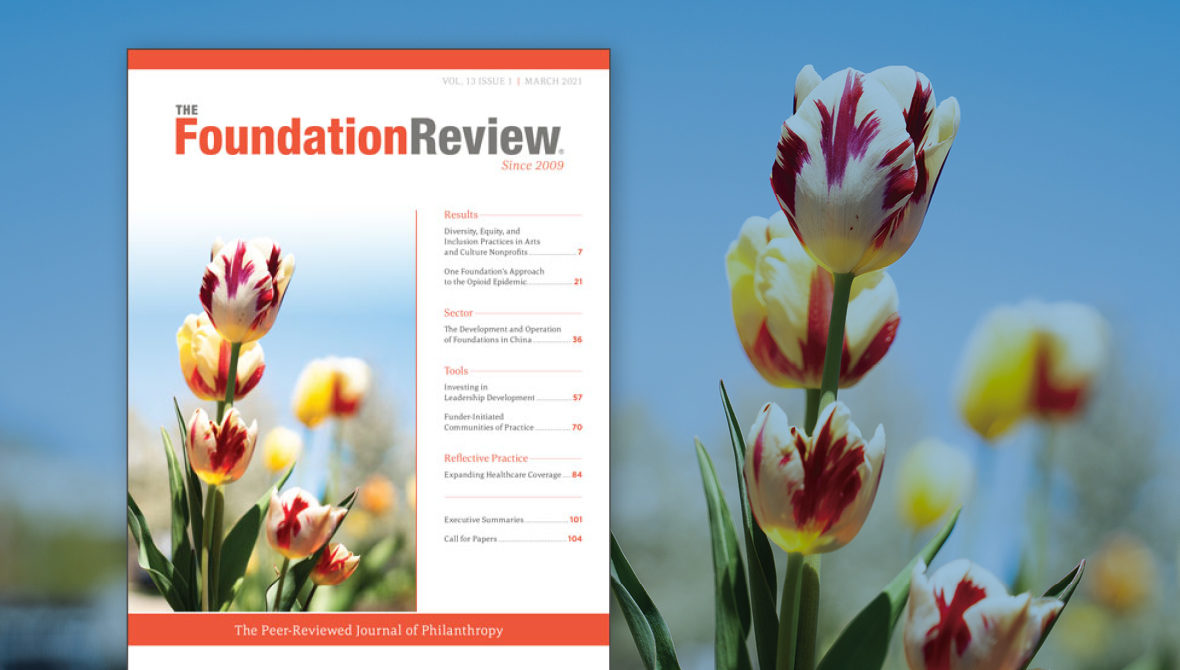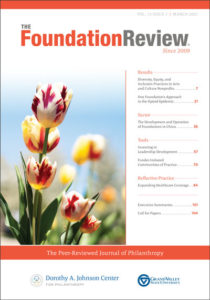Strengthening Our Work Together


 Volume 13, issue 1 of The Foundation Review comprises an eclectic set of articles on the work of foundations. A theme across all of these articles, though, is the importance of collaboration, whether with peers to foster learning, or across sectors and organizations within communities — or across the globe — to achieve impact.
Volume 13, issue 1 of The Foundation Review comprises an eclectic set of articles on the work of foundations. A theme across all of these articles, though, is the importance of collaboration, whether with peers to foster learning, or across sectors and organizations within communities — or across the globe — to achieve impact.
In these divisive times, we hope these articles suggest ways to strengthen our work together.
Here, McClelland summarizes the findings of a survey conducted by the Bonfils-Stanton Foundation of leaders from 10 arts and culture nonprofits. The author recommends that arts grantmakers can most effectively support nonprofits in their diversity, equity, and inclusion work through building the field, supporting a diverse workforce, and measuring progress. As more funders intentionally focus on equity and justice, asking grantees what they need to support their DEI efforts is a critical step.
While the COVID pandemic has captured the attention of the world, the opioid epidemic is still with us. It is one of many examples of foundations grappling with complex, cross-sector societal problems. In this article, Yegian describes a major effort by the California Health Care Foundation to reduce opioid-related morbidity and mortality. Their early investment had dramatic returns, laying the groundwork for scaling pilot projects statewide as hundreds of millions of dollars in government funding became available to address the crisis. Bridging across sectors, providing resources beyond dollars, and co-creation with grantees were key strategic choices that the author suggests might apply to addressing other complex social issues.
As philanthropy becomes increasingly globalized, it is important to understand cultural influences on how philanthropy is practiced. This understanding is particularly critical for funders who seek to partner internationally. Wang explores the history of Chinese foundations and examines their relationships with overseas funders across three time periods, providing practical information to practitioners who work, or will work, for or with foundations in China.
In this article, Arnold, Blackmur, Solórzano, Kong, Wunsch, and Mutha share their experiences with a 12-year investment by Blue Shield of California Foundation growing a pool of community health center leaders. The Clinic Leadership Institute was implemented in partnership with Healthforce Center at University of California, San Francisco in anticipation of a generation of health center leaders beginning to retire. A study spanning 10 cohorts of CLI alumni found that CLI served a critical role in supporting community health center leaders and their organizations in navigating these changes. As we anticipate extensive turnover in the leadership of the nonprofit sector in the near future as the baby boom generation retires, developing a more diverse pool of people equipped to take on leadership is critical. Focusing on building leadership for specific types of organizations, rather than broad leadership development, is a strategy to consider.
Bringing grantees together to share learning is a common practice in philanthropy. Nicklin, Chancellor, Garcia, Gohole, Haussmann, Kaijage, Cady, Miller, Moore, Nelson, Powers, and Somé explore the degree to which funders can initiate longer-term peer learning through communities of practice. The McKnight Foundation’s Collaborative Crop Research Program initiated, supported, and participated in a CoP comprised of its grantees to share and create knowledge. Long-term investment in convenings and facilitation and relinquishing some control over outcomes were key to actors in Africa and the Andes region to develop adaptive capacity related to food system research and action through social learning. While convenings and networking meetings are helpful, this work shows that intentional long-term investment in shared learning should be considered as a key tactic.
In 2013, Missouri Foundation for Health launched a five-year effort to reduce Missouri’s uninsured rate. A broad-based state coalition employed a three-pronged approach: awareness building and outreach, enrollment assistance, and increasing health literacy. Saltzman, Spilker, and Klenke-Isgriggs report that the rate of uninsured Missourians dropped to 9% during the initiative’s time frame. Coalition members pointed to the value of collaboration, access to expertise, the locally tailored approach of the initiative, and the maintenance of a politically neutral stance in the effort to support the implementation of a complex federal policy.
Explore the full issue here. Not yet a subscriber? Click here to start your free 90-day trial.